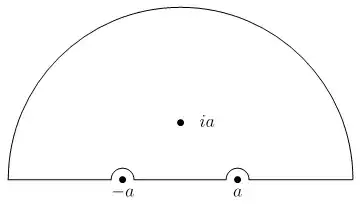@Doug M already posted an answer assuming that $a$ is neither real nor pure imaginary. In this answer, I will tackle the opposite case, i.e., the case with $a > 0$.
If $a > 0$, then the integrand suffers from poles $\pm a$ along the real line, and so, the integral does not converge in ordinary sense. For this reason, we will interpret the integral in Cauchy principal value sense. Then by noting that the imaginary part of the integrand is an odd function, we get
$$ I
:= \frac{1}{2\pi} \operatorname{PV}\! \int_{-\infty}^{\infty} \frac{e^{i(x-y)\tau}}{\tau^4-a^4} \, \mathrm{d}\tau
= \frac{1}{2\pi} \operatorname{PV}\! \int_{-\infty}^{\infty} \frac{\cos((x-y)\tau)}{\tau^4-a^4} \, \mathrm{d}\tau. $$
In particular, the integral depends only on $k := \left| x - y \right|$.
Now by applying the residue theorem applied to the contour integral along the dented semicircular arc

and then letting the outer radius to $\infty$ and the inner radii to $0^+$, we get
\begin{align*}
I
&= \frac{1}{2\pi} \operatorname{PV}\! \int_{-\infty}^{\infty} \frac{e^{ik\tau}}{\tau^4-a^4} \, \mathrm{d}\tau \\
&= \frac{1}{2\pi} \biggl( i\pi \, \mathop{\operatorname{Res}}_{z=a} \, \frac{e^{ikz}}{z^4-a^4} + i\pi \, \mathop{\operatorname{Res}}_{z=-a} \, \frac{e^{ikz}}{z^4-a^4} + 2i\pi \, \mathop{\operatorname{Res}}_{z=ia} \, \frac{e^{ikz}}{z^4-a^4} \biggr) \\
&= \frac{i}{2} \frac{e^{ika}}{4a^3} + \frac{i}{2} \frac{e^{-ika}}{4(-a)^3} + i \frac{e^{-ak}}{4(ia)^3} \\
&= - \frac{1}{4a^3}\bigl( \sin(ak) + e^{-ak} \bigr) \\
&= - \frac{1}{4a^3}\bigl( \sin(a\left|x-y\right|) + e^{-a\left|x-y\right|} \bigr).
\end{align*}
Notice that this coincides with the real part of the proposed answer by OP.
